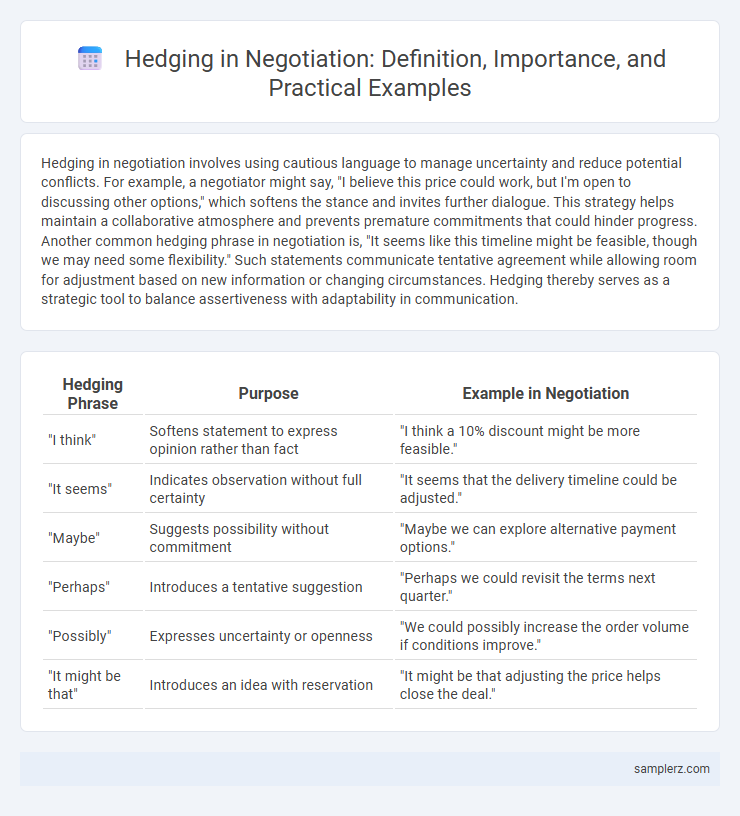Hedging in negotiation involves using cautious language to manage uncertainty and reduce potential conflicts. For example, a negotiator might say, "I believe this price could work, but I'm open to discussing other options," which softens the stance and invites further dialogue. This strategy helps maintain a collaborative atmosphere and prevents premature commitments that could hinder progress. Another common hedging phrase in negotiation is, "It seems like this timeline might be feasible, though we may need some flexibility." Such statements communicate tentative agreement while allowing room for adjustment based on new information or changing circumstances. Hedging thereby serves as a strategic tool to balance assertiveness with adaptability in communication.
Table of Comparison
| Hedging Phrase | Purpose | Example in Negotiation |
|---|---|---|
| "I think" | Softens statement to express opinion rather than fact | "I think a 10% discount might be more feasible." |
| "It seems" | Indicates observation without full certainty | "It seems that the delivery timeline could be adjusted." |
| "Maybe" | Suggests possibility without commitment | "Maybe we can explore alternative payment options." |
| "Perhaps" | Introduces a tentative suggestion | "Perhaps we could revisit the terms next quarter." |
| "Possibly" | Expresses uncertainty or openness | "We could possibly increase the order volume if conditions improve." |
| "It might be that" | Introduces an idea with reservation | "It might be that adjusting the price helps close the deal." |
Understanding Hedging in Negotiation
Hedging in negotiation involves using cautious language to reduce commitment and maintain flexibility, such as phrases like "It seems," "Possibly," or "We might consider." This technique helps negotiators manage uncertainty and mitigate risks by avoiding definitive statements that could limit options. Understanding hedging enables parties to communicate strategically, fostering cooperation without overpromising or creating rigid expectations.
Common Phrases for Hedging During Talks
Common phrases for hedging during negotiation include expressions like "It seems that," "I'm not entirely sure, but," and "Perhaps we could consider." These hedging terms help soften statements, allowing negotiators to propose ideas without committing fully or risking strong disagreement. Using phrases such as "To some extent," "One possibility might be," and "It could be beneficial if" supports flexibility and preserves open communication during sensitive discussions.
Strategic Use of Hedging to Build Trust
In negotiation, using hedging phrases such as "I believe," "it seems," or "perhaps" strategically softens statements, reducing the risk of overcommitment and allowing room for adjustment. This cautious language signals openness and flexibility, fostering mutual respect and trust between parties. Employing hedging creates a collaborative atmosphere that encourages dialogue and minimizes potential conflicts.
Mitigating Risks: Hedging Language Examples
Using phrases such as "It seems likely that," "There is a possibility that," and "We might consider" effectively mitigates risks in negotiation by softening commitments and allowing flexibility in outcomes. Employing hedging language helps parties avoid overpromising and fosters a collaborative atmosphere where adjustments can be made as new information arises. This strategic use of cautious language reduces potential conflicts and promotes mutual understanding in high-stakes communication.
How Hedging Softens Demands in Negotiations
Hedging softens demands in negotiations by using cautious language such as "I think," "perhaps," or "it might be possible," which reduces the risk of outright rejection and maintains a collaborative tone. Phrases like "Could we possibly consider" or "Would it be acceptable" allow negotiators to present proposals without imposing rigid terms, facilitating flexibility and openness. This strategic use of hedging minimizes confrontation and encourages mutual understanding, enhancing the likelihood of a successful agreement.
Role of Hedging in Managing Conflict
Hedging in negotiation plays a crucial role in managing conflict by softening statements to reduce potential offense and maintain a collaborative atmosphere. Phrases such as "I believe," "it seems," or "perhaps we could consider" allow negotiators to present ideas without appearing confrontational or overly assertive, facilitating open dialogue. This approach minimizes defensiveness, promotes flexibility, and supports mutual understanding in resolving disagreements effectively.
Cultural Differences in Hedging Strategies
In negotiation, hedging strategies vary significantly across cultures, with East Asian negotiators often employing indirect language and vague expressions to maintain harmony and avoid confrontation. Western cultures, by contrast, tend to prefer more explicit, direct hedges such as "I think" or "perhaps" to introduce uncertainty while preserving clarity. Understanding these cultural differences in hedging can enhance cross-cultural communication effectiveness and prevent misunderstandings during international negotiations.
Impact of Hedging on Negotiation Outcomes
Hedging in negotiation, such as phrases like "I think" or "It seems," reduces the risk of conflict and preserves relationships by softening statements. This strategic use of uncertainty fosters collaboration and increases the likelihood of mutually beneficial agreements. Research shows that effective hedging mitigates resistance and enhances trust, leading to more successful negotiation outcomes.
Effective Hedging Techniques for Win-Win Solutions
Effective hedging techniques in negotiation involve using language that softens demands while maintaining clear intentions, such as phrases like "It seems possible that," or "One option might be." These strategies help create a collaborative atmosphere by reducing perceived threats and encouraging flexibility, supporting mutual understanding. Employing skilled hedging contributes to win-win solutions by balancing assertiveness with openness to alternative proposals.
Pitfalls to Avoid When Hedging in Negotiation
Hedging in negotiation can lead to ambiguity and misinterpretation, increasing the risk of unresolved conflicts or weakened agreements. Overusing tentative language such as "maybe," "possibly," or "I think" can undermine credibility and reduce persuasive power. It is essential to balance caution with clarity to maintain trust and effectively advance negotiation objectives.

example of hedging in negotiation Infographic
 samplerz.com
samplerz.com